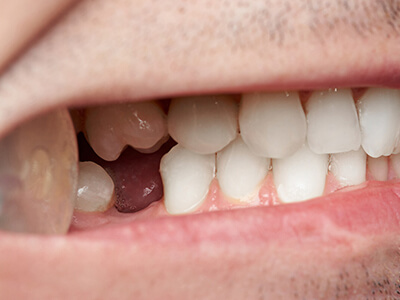
Dental Bridges – Fort Worth, TX
Long-Lasting Tooth Replacement Treatment
If you’re missing one or more consecutive teeth, although it may not seem like a major issue, it’s vital to replace them to prevent problems from developing down the road. Not only can the space in your arch make it hard to chew food and absorb vital nutrients you’re consuming, but it can also cause embarrassing speech problems. With dental bridges in Fort Worth, you can restore the function and feel of your smile while preserving your oral health.

Why Choose Summer Creek Dentistry for Dental Bridges?
- Durable & Strong Dental Materials
- Customized For A Natural Fit & Feel
- In-House Dental Implant Bridge Placement
The Process of Getting a Fixed Bridge

Fixed bridges consist of two dental crowns on either side of free-standing replacement teeth called pontics. The restoration is made of customizable, natural-looking materials, like dental porcelain and ceramic, that are meant to flawlessly blend in with the rest of the arch.
The first step of the dental bridge process is acquiring impressions of the gap in your arch. We’ll send this off to our dental laboratory to have them custom-craft your bridge. We’ll also prepare the two teeth on either side of the gap before we send you on your way. When your bridge arrives at the office, you’ll come in again, so we can permanently secure it in place and bridge the gap in your arch.
Why Is It Important to Replace Missing Teeth?

Missing teeth can cause a variety of problems when they’re not addressed, that’s why we recommend having them replaced as soon as possible. Without restoring them, you could run into issues such as:
- Surrounding teeth drifting to fill the gap and causing misalignment.
- Difficulty chewing and digesting food properly.
- Declining oral health due to increased risk of issues such as cavities.
- Difficulty pronouncing certain sounds.
- Decreased self-confidence.
When you restore your smile, you can boost your self-esteem and improve your daily quality of life, making the choice of getting a dental bridge in Fort Worth a no-brainer.
The Benefits of Fixed Bridges

There are countless benefits of getting a dental bridge in Fort Worth. Whether you choose to have one retained by two dental implants or get a traditional bridge, both can preserve your oral health and the alignment of your teeth. The bridge itself is crafted from durable and strong dental materials that will last for over a decade with daily brushing and flossing as well as routine checkups and cleanings. Plus, with a complete and healthy smile, you’ll be able to feel more confident about letting it show.
Dental Bridges FAQs
Can You Take a Dental Bridge Out?
Dental bridges are designed to remain in place for many years, so they should not be removable by anyone other than a qualified dental professional such as Dr. King. While you may have heard of “removable bridges” from some healthcare providers, this is a misnomer that refers to partial dentures. While partial dentures are quite similar to dental bridges, the patient can remove them at any time.
Is Getting a Dental Bridge Painful?
Dr. King will administer an appropriate local anesthetic to ensure your comfort while your mouth is prepared to receive a dental bridge. This will involve either reshaping the teeth on either side of the gap in your smile to host dental crowns or placing dental implants in the jawbone to provide the bridge with the most secure hold possible. Some patients may also need dental sedation treatments to sit comfortably during this part of the process. While you may experience some soreness or sensitivity in the days afterward, this can be managed with over-the-counter pain medications and by adhering to your aftercare instructions. However, call our office if your discomfort seems to be getting worse. Bridges can also prevent teeth from drifting out of place, which can prevent discomfort later on.
How Many Teeth Can a Dental Bridge Replace?
A dental bridge can replace anywhere from one to four sequential missing teeth depending on the patient’s particular needs. However, bridges are usually only used to replace one or two teeth since replacing more can make the appliance unstable and more likely to break. While a traditional bridge is significantly more likely to fail if it replaces too many teeth, an implant bridge with three or four teeth may be able to provide a stronger restoration since they are just as secure as natural dental structures.
Do Dental Bridges Look Natural?
Metal-free bridges made from ceramic materials such as dental porcelain can be color-matched to your existing teeth, creating a lifelike restoration that will go unnoticed by casual observers. While bridges made from gold or silver are much more conspicuous, they are usually used to replace teeth in the back of the mouth that are much less noticeable. Bridges will also not fall out during speech or meals, which can be a significant problem for people wearing dentures.
Can Dental Bridges Get Cavities?
While it’s impossible for a dental bridge to get cavities, the teeth hosting the crowns anchoring it in place still can. This problem becomes much more likely if food debris is allowed to accumulate beneath the bridge or where the crowns make contact with the gums. If the teeth supporting a dental bridge become decayed, the appliance will probably have to be removed so the infection can be treated and possibly replaced afterward. However, the cement supporting an older bridge can sometimes begin to crack due to age, which can allow bacteria to infect the teeth supporting the appliance. In any case, the best ways to keep your bridge healthy are proper oral hygiene at home and regular visits at our office in Fort Worth.